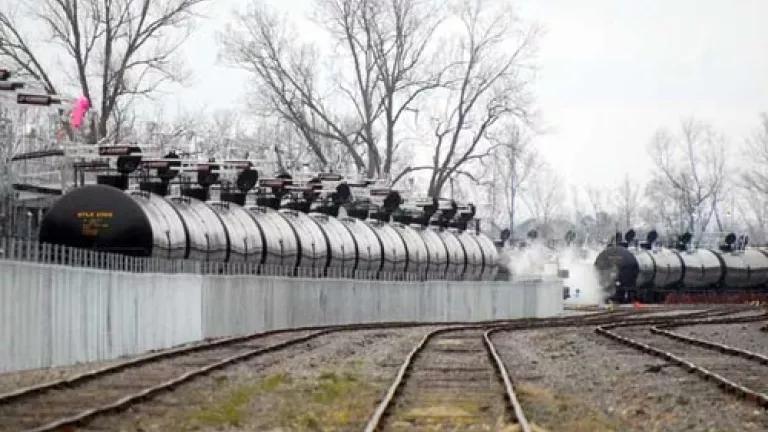Tar Sands Train to Ruin: HowTar Sands Producer Southern Pacific Resources Is Going Broke on Shipping Tar Sands by Rail

This blog was co-written with Lorne Stockman, Research Director at Oil Change International
In the summer of 2012, advocates of Keystone XL hailed Southern Pacific Resources’ announcement that it had signed a five-year contract to bypass pipeline bottlenecks and ship tar sands by rail to the Gulf Coast as proof that tar sands projects would move forward with or without pipelines. Two years after becoming the first tar sands producer to attempt to rely entirely on rail to ship its production to the Gulf, Southern Pacific Resources’ stands on the brink of financial ruin. Rather than proving that rail can be an alternative to pipelines to the Gulf Coast, Southern Pacific Resources’ experience illustrates the profound economic obstacles associated with tar sands production. The poor performance of tar sands by rail to the Gulf has only proved why the industry needs projects like the proposed Keystone XL pipeline to expand.
Southern Pacific Resources’ plan called for the production from its McKay project to be shipped 2,800 miles by rail over Canada National’s rail network to a terminal in Natchez, Mississippi, where it would be transferred by barge to refineries on the Gulf Coast. The first shipment of diluted bitumen was railed from Fort McMurray on December 22, 2012, arriving in Mississippi fifteen days later.
The plan involves hefty costs. Southern Pacific Resources estimated its shipping costs at $31 per barrel, over three times the $9.50 per barrel cost of the proposed Keystone XL tar sands pipeline. However, Southern Pacific Resources noted that alternative tar sands pipelines weren’t available, citing opposition to Keystone XL and Northern Gateway. Moreover, Southern Pacific argued that the higher costs of rail would be partially offset by higher oil prices on the Gulf Coast, reduced diluent costs and the possibility of backhauling diluent to Canada.
The State Department looked to Southern Pacific Resources as an example of the feasibility of tar sands by rail to the Gulf. In its March 2013 environmental assessment of Keystone XL, State cited Southern Pacific Resources’ proposal five year contract as the first sign that tar sands companies were considering over the long term. Moreover, State cited Southern Pacific Resources plan to ship tar sands as railbit (reducing diluent costs) and backhauling diluent back to Alberta (reducing shipping costs) to conclude that tar sands by rail was an economically viable alternative to pipelines.
Unfortunately for Southern Pacific Resources, it hasn’t worked out. The combination of high transportation costs and poor performance at its main tar sands SAGD project have driven the company to the verge of bankruptcy. Southern Pacific Resources expected its tar sands by rail deal to improve its average operating netbacks (the difference between oil price received and both operating and transportation costs) once it started making deliveries in January 2013. However, the company’s financial records show that its 2013 operating netbacks had declined by 99%, from $34.75 a barrel to $0.27 a barrel. Despite receiving somewhat higher oil prices, Southern Pacific Resources paid about $20 per barrel more to ship its product. These higher transportation costs, combined with higher production costs, dramatically eroded its operating profit margins.
Since announcing its plan to rely on rail to ship tar sands to the Gulf, the company’s shares have lost 98% of their value and have been trading in recent weeks at just 2 or 3 cents a share. Even its bondholders have lost nearly half of their principle.
Two years after Southern Resources CEO Byron Lutes hailed its tar sands by rail arrangement as significant “because it demonstrates that alternatives to conventional pipelines are available to market bitumen from the Athabasca oil sands,” he would blame the lack of export pipelines for his inability to find new investors.
As we noted last week, shipping tar sands by rail to the Gulf has proven an unprofitable business for rail terminal companies. Southern Pacific Resources’ slide to insolvency demonstrates that it’s not a profitable alternative for tar sands producers either. That’s why volumes of tar sands by rail to the Gulf haven’t reached a fraction of the levels forecast by Keystone XL advocates or the State Department. Two years ago, the Southern Pacific Resources tar sand by rail business model may have appeared compelling to outside observers. That’s not the case today.
Southern Pacific Resource’s example demonstrates exactly why the proposed Keystone XL tar sands pipeline is so critical for the tar sands industry’s expansion plans – and the substantial carbon emissions associated with them.

